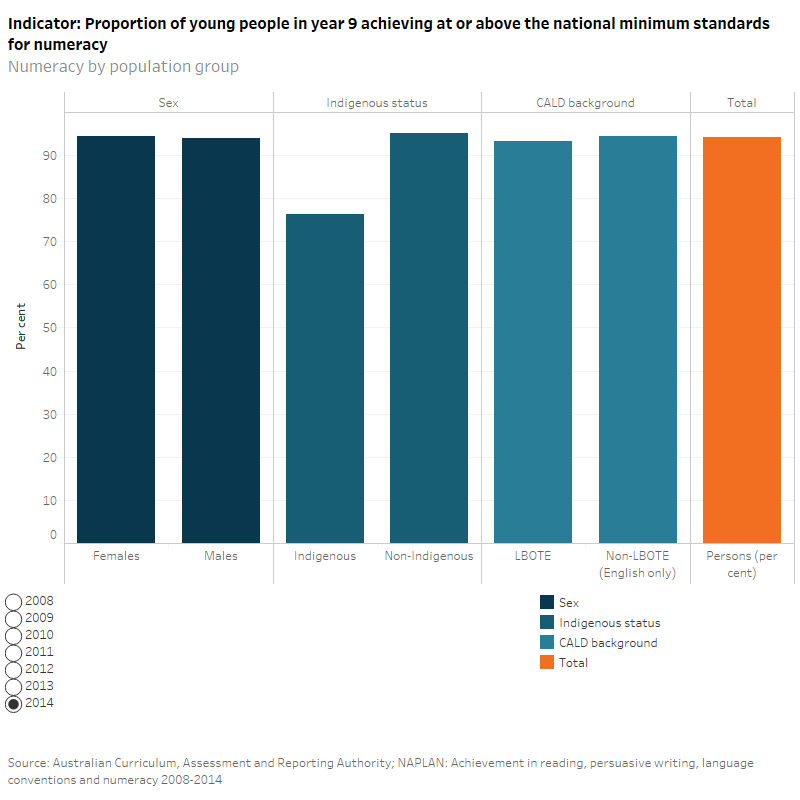Numeracy
Why are numeracy rates important?
Numeracy skills are essential for young people to engage in day-to-day living, further educational attainment, social development and employment. Numeracy involves the understanding and application of mathematical information across a range of situations in daily life. A broader definition of numeracy provided by the OECD is the ability to access, use, interpret and communicate mathematical information and ideas, in order to engage in and manage the mathematical demands of a range of situations in adult life (Schneider et al. 2010).
Young people who can apply mathematical concepts in a number of different contexts are in a better position to succeed in education and in life (DECD 2013). Successful educational outcomes are influenced by a range of factors including a young person’s home environment, the quality of their educational experiences and their attitude to school and learning (Walsh and Black, 2009). Additionally, there are a number of other factors that have been shown to influence educational outcomes, including resources, parental level of education, school engagement, and socioeconomic status (Walsemann et al. 2008, Zammit et al. 2002).
Do numeracy rates vary across population groups?
In 2014, the majority of Year 9 students achieved at or above the national minimum standards of numeracy (around 94%). Similar proportions of males and females achieved at or above the national minimum standards, both with 94%. Non-Indigenous students were more likely to achieve at or above the national minimum standards for numeracy than Indigenous students (95% compared to 76% respectively). Students from English-speaking backgrounds were only slightly more likely to achieve at or above the national minimum standards in numeracy than those with a language background other than English (LBOTE) (95% compared to 93%).
Has there been a change over time?
The proportion of students achieving at or above the national minimum standards for numeracy has remained relatively steady at 94% between 2008 and 2014. Over the same period, very similar trends were observed among males and females with proportions at around 94%. The proportion of Indigenous students achieving at or above the national minimum standards ranged from 66% to 76%. The trend for non-Indigenous students between 2008 and 2014 was higher and more stable than Indigenous students with proportions at 95%. For students with a LBOTE and non-LBOTE status the percentage of students achieving at or above the national minimum standards for numeracy remained steady between 2008 and 2014 (90% and 94% respectively).

The National Assessment Program – Literacy and Numeracy (NAPLAN) tests are the only Australian assessments that provide nationally comparable data on the performance of students in the vital areas of literacy and numeracy.
CALD refers to Culturally And Linguistically Diverse Background.
LBOTE refers to Language Background Other Than English.
Data quality statement: Please refer to the published source (above) for further information.
DECD (Department for Education and Child Development) 2013. Numeracy and literacy: a numeracy and literacy strategy from birth to 18. Adelaide: Government of South Australia (Department for Education and Child Development).
Schneider, B, Keesler, V, Morlock, L 2010. The effects of family on children’s learning and socialisation, in OECD (2010). The Nature of Learning, OECD Publishing.
Walsemann K, Geronimus A & Gee G 2008. Accumulating disadvantage over the life course: evidence from a longitudinal study investigating the relationship between educational advantage in youth and health in middle age. Research on Aging 30(2):169–99.
Walsh L & Black R 2009. Overcoming the barriers to engagement and equity for all students. Canberra: Foundation for Young Australians.
Zammit S, Routitsky A & Greenwood L 2002. Maths and science achievement of junior secondary school students in Australia (TIMSS Australia monograph no. 4). Melbourne: Australian Council for Educational Research.


